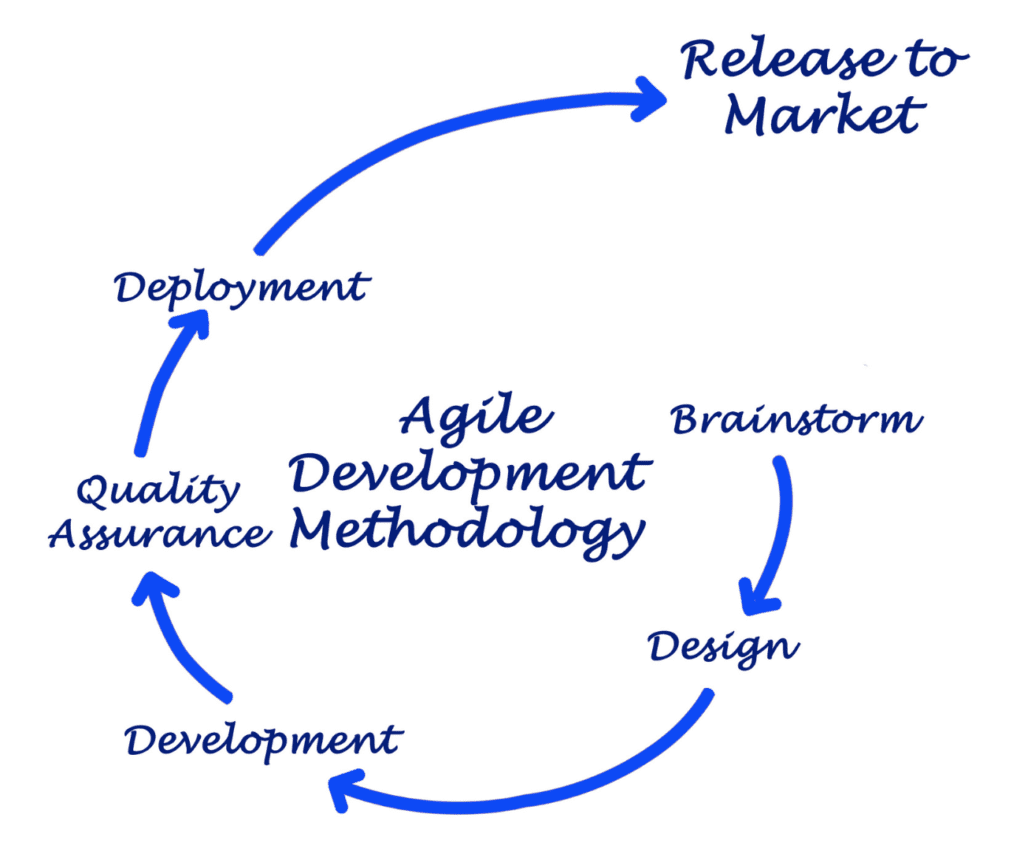An agile software development life cycle constitutes a decluttered approach to finishing work.
The term: “decluttered” is more of a broad spectrum phenomenon where different phases of agile methodology come into play. You have an agile development cycle manifesto to follow, different communication and collaboration strategies to implement, Scrum, feature-driven development, and vice versa.
Eventually, all the aforementioned aspects of the agile software development life cycle conjoin on one platform, shaping an MVP towards a finished product. That’s what it’s all about.
However, for argument’s sake, if you have never heard of the agile development cycle, or someone who owns a business and wishes to implement different phases of agile methodology, this post sheds insight in that direction.
Since software planning and development isn’t all about executing ideas on a whim these days, this post offers a drill-down analysis of everything there is to the agile development cycle, agile methodology phases, and more.
Let’s get started.
What is the Agile Software Development Life Cycle?

The Agile SDLC methodology consists of collaborative decision-making between teams working on creating fully functional software.
This software development is based on cyclical and iterative models and is completed in repetitive sprints that usually last a few weeks.
Here are some of the popular agile methodology phases that come under the Agile software development program.
- Adaptive Software Development
- Kanban
- Scrumban
- Dynamic Systems Development (DSDM)
- Lean Software Development
- Disciplined Agile Delivery (DAD)
- Agile Modeling
- Scrum
- Extreme Programming (XP)
- Feature Driven Development
When we talk about the agile software development lifecycle, the whole point of the exercise is to make sure that the team creates working software and delivers it to the client as quickly as possible.
But with so many ways to achieve that, you have to make sure that you choose the right methodology, otherwise, you are never going to achieve your goal according to your needs and requirements.
Let’s now look at the agile process flow and find out how things work.
Agile Process Flow

Here is a list of steps that are included in the agile process flow.
- Concept: In this step of the agile process flow, projects are prioritized and envisioned for future development
- Inception: In the second step, all of the team members that are going to work in the agile software development lifecycle are identified, the initial environments and the requirements are discussed, and the budget for the whole endeavor is set
- Iteration: In this step, the development team working on the project works diligently to deliver a working piece of software that is developed iteratively with the help of requirements set at the start and the feedback that is received from the users
- Release: In this step, quality assurance testing, documentation development, and internal and external training are performed, and the final release of the iteration is pushed into production
- Production: In the production step of the agile process flow, there is the ongoing support of the software
- Retirement: In the last step of the agile process flow, all of the activities come to an end, including the migration and the customer notifications
Making Agile Work for You and Your Project
As we know, there are many advantages and disadvantages to every single agile methodology.
One thing that you need to understand is that the correct scenario to use the agile method is where the project stakeholders and the customers are readily available to give their valuable feedback.
Also, agile is used when the functional portions of the software or a ready software are quickly needed without any delay.
It is also used when flexibility is required to make sure that all of the changing requirements and needs are going to be well taken care of, and all of the team members can effectively collaborate.
But as with any change or difference in the normal course of events, integrating agile into all of the different aspects of your business can be quite challenging and overwhelming.
That is why we are going to talk about 4 activities that you can perform to seamlessly incorporate agile into your business. They are:
- Live Demonstrations: In this activity, the project managers or the people in charge deliver love demonstrations of the iterations that are happening in the software development cycle to show the progress of the whole process for everyone to see
- Remain Agile: In this step of the process, the changes that are received from the users or the customers are incorporated in the overall software development, so that the next iteration or the version of the software is better than the last one
- Daily Meetings: One of the most important interactions that the agile team has with each other is daily meetings. The project manager host different and consistent stand-up meetings to make sure that the team members are in-sync and there are no gaps when it comes to communication
- Share Feedback: In this step, the people in charge of the project receive different feedbacks from the customers and the stakeholders associated with the software and share that entire information with the development team before the next iteration begins so that they can have a better idea of what to do and what not to do in the next iteration
Why Agile Methodology Phases Are Worth Implementing For an In-House Software Development Business?

Agile methodology has become increasingly popular in software development because it offers several benefits for businesses, including:
Faster Time-to-Market:
Agile methodology is designed to deliver working software in short iterations, allowing businesses to release new features and updates quickly and frequently.
Increased Flexibility:
Agile methodology allows for changes and adjustments to be made throughout the development process, enabling teams to respond quickly to changing requirements or market conditions.
Improved Quality:
Agile methodology emphasizes collaboration, continuous testing, and feedback, resulting in higher quality software that meets user needs and expectations.
Increased Customer Satisfaction:
Agile methodology puts the customer at the center of the development process, resulting in software that is more closely aligned with their needs and expectations.
Implementing Agile methodology phases in an in-house software development business can help teams deliver high-quality software more efficiently.
Here are the key phases of Agile methodology for small in-house software businesses these days.
Planning: In the planning phase, the team defines the project scope, identifies the requirements, and creates a roadmap for the project.
Design: In the design phase, the team creates a detailed design of the software, including the user interface, architecture, and data models.
Development: In the development phase, the team builds the software in short iterations, working closely with the customer to ensure the software meets their needs and expectations.
Testing: In the testing phase, the team conducts testing throughout the development process to ensure the software meets quality standards and functional requirements.
Deployment: In the deployment phase, the team releases the software to production, ensuring that it is stable, secure, and meets the customer’s expectations.
Maintenance: In the maintenance phase, the team provides ongoing support and maintenance for the software, including bug fixes and updates.
By following these phases, an in-house software development business can generate innovative mobile app ideas and build high-quality software that meets customer needs and expectations, while also delivering it quickly and efficiently.
In addition to that, Agile methodology helps businesses to be more adaptable to changing market conditions, ensuring that they can respond quickly to new opportunities and challenges.
Limitations of Different Phases of Agile Methodology
Of course, as perfect as it may seem, agile methodology comes with a bunch of limitations.
Depending on your business and deliverables, these constraints will vary. Here’s what you need to know about limitations of phases of agile methodology.
Keep in mind that these limitations are explained at a sub-level from aspect-by-aspect perspective.
Planning:
- Lack of detailed documentation: Agile methodology emphasizes minimal documentation, which can be a challenge when extensive documentation is required for certain projects or industries.
- Difficulty in estimating timelines: Agile planning relies on short iterations and adapting to changing requirements, making it challenging to estimate project timelines accurately.
Design:
- Limited upfront design: Agile promotes iterative design, which may not be suitable for projects that require extensive upfront planning and design, such as complex systems or safety-critical applications.
- Lack of comprehensive architectural overview: Agile may not prioritize creating a detailed architectural design upfront, which can be a limitation for projects that require a robust and scalable architecture.
Development:
- Dependency on team collaboration: Agile relies heavily on effective team collaboration and communication. If teams are distributed or lack cohesion, it can impact productivity and progress.
- Balancing features and technical debt: The focus on delivering features quickly may result in accumulating technical debt if there is not enough attention given to maintaining code quality and architecture.
Testing:
- Limited documentation: Agile promotes lightweight documentation, which can make it challenging to maintain comprehensive test cases and traceability, particularly for projects with strict regulatory requirements.
- Time constraints: The iterative nature of Agile can sometimes lead to time constraints, limiting the thoroughness of testing efforts and potentially affecting the quality of the software.
Deployment:
- Integration challenges: Frequent releases and iterative development may require robust integration and deployment processes to ensure smooth deployments and minimize disruptions.
- Compatibility issues: Rapid changes and iterations can introduce compatibility issues with existing systems or third-party integrations, requiring careful coordination and testing.
Maintenance:
- Balancing new features and maintenance: The continuous focus on new feature development can make it challenging to allocate sufficient resources for ongoing maintenance and support.
- Legacy code management: Projects with long lifecycles may accumulate legacy code and technical debt, requiring dedicated efforts to refactor and improve the system over time.
Understanding these limitations and constraints can help organizations plan and adapt their Agile implementation to address potential challenges effectively.
It’s an Ongoing Process
Having talked about agile software development life cycle, we’d like to say that it’s a constantly evolving phenomenon where new things are being discovered and developed by each day.
As technology gives way to new solutions and gadgets, the way work is delivered and process efficiency is changing.
What do you think about phases of agile methodology? Have you implemented any of it before? We’d love to hear from you in the comments section below.

